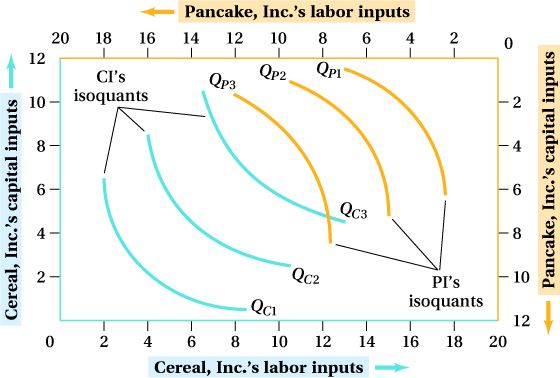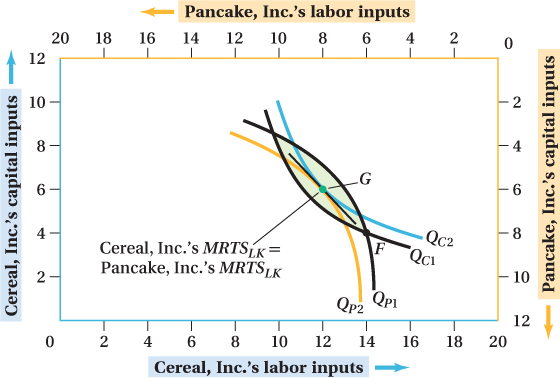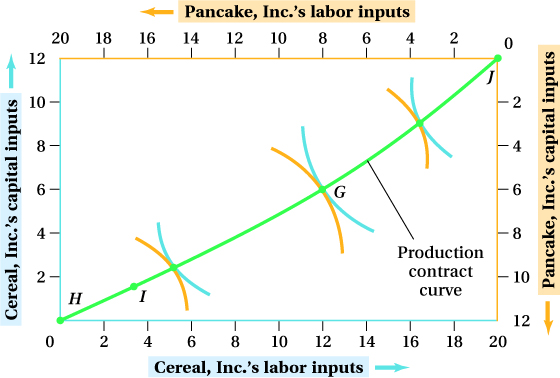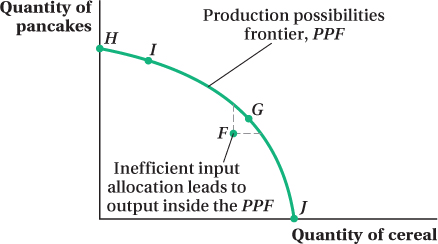15.4 Efficiency in Markets: Input Efficiency
Exchange efficiency shows what conditions must hold on the demand side of a market for the market to be efficient. Efficiency is also important on the production side of the economy, especially the efficiency with which inputs are allocated across the production of various goods and services. An input can be used to make one product or another, but not both simultaneously. So, which product should it be used to make? That is, how do we answer questions such as how much steel should be used to make cars instead of kitchen knives and surgical instruments, or how many workers should work in which industries? Questions like these are at the heart of the second market efficiency condition of general equilibrium, input efficiency.
Many of the tools we used to analyze exchange efficiency are also useful in analyzing input efficiency. We saw that in exchange efficiency, goods are consumed where consumers’ indifference curves are tangent to one another. Similarly, input efficiency requires an allocation of inputs across producers where their isoquants are tangent to each other. The reasoning is similar to the exchange efficiency case. At locations where producers’ isoquants are tangent to each other, no input can be transferred from one producer to another without at least one experiencing a loss in output.
Because of the similarity of the two problems, we use an Edgeworth box for our analysis. It’s just like the one we used for Elaine and Jerry, except with two producers instead of two consumers. And rather than allocating two goods between consumers, we look at how two inputs are allocated between the producers.
598
Figure 15.9 shows how 20 units of labor (horizontal axes) and 12 units of capital (vertical axes) are allocated between Cereal, Inc. (CI) and Pancake, Inc. (PI). CI’s origin, which denotes where it is using 0 units of capital and labor, is at the lower-

The connection between the analysis of Elaine and Jerry’s consumption bundles and the analysis of Cereal, Inc.’s and Pancake, Inc.’s input use is direct. CI’s isoquants look “normal.” PI’s isoquants also look normal if we remember that we’re looking at them from the upper-

At input allocation G, where CI’s and PI’s isoquants QC2 and QP2 are tangent, there is no way to move labor and capital from one firm to the other and raise output for at least one of the firms without reducing the other firm’s output. Therefore, G is a Pareto-
There are more similarities between input and exchange efficiency. Exchange efficiency implies that consumers’ marginal rates of substitution— . In our example, input efficiency requires that
. In our example, input efficiency requires that
599

We can see this common MRTSLK slope in Figure 15.10.
We also learned in Chapter 6 that cost-

where W is the wage rate and R the capital rental rate.
production contract curve
Curve that shows all Pareto-
Finally, a similarity exists between input and exchange efficiency in terms of the set of efficient allocations. In the exchange efficiency case, the collection of efficient goods allocations, the consumption contract curve, connects all common tangencies of the consumers’ indifference curves. The production contract curve connects all common tangencies of producers’ isoquants and contains all efficient allocations of inputs across producers (Figure 15.11).

Just as different locations on the contract curve can imply very different total utility levels for Elaine and Jerry, different locations on the production contract curve correspond to disparate production quantities of cereal and pancakes. In the lower left, Cereal, Inc. uses few inputs and relatively little cereal is made, while many pancakes are produced. The opposite is true in the upper-
600
The Production Possibilities Frontier
The production contract curve generates a useful idea. Think about what various input allocations across the two firms imply about the tradeoffs between the output of either good. Imagine running along the production contract curve from the lower-
At the very lower-

601
Now move up and to the right along the production contract curve to input allocation I in Figure 15.11. This move shifts inputs from pancake to cereal production. The corresponding effect on output is traced by the movement from point H to point I in Figure 15.12. Cereal output increases while pancake output falls. As we continue in the same direction along the production contract curve, cereal production rises further as pancake production drops more. When we reach the upper-
production possibilities frontier (PPF)
Curve that connects all possible efficient output combinations of two goods.
We just traced out all the possible combinations of the cereal and pancakes that could be made if inputs are allocated efficiently across producers. The level of output for any particular good will depend on how many inputs are applied to its production, but whatever level this is, as long as the input allocation is on the production contract curve, efficiency tells us we cannot increase the output of the other good without decreasing the output of the first. The curve that connects these possible output combinations, curve HJ in Figure 15.12, is called the production possibilities frontier (PPF). Again, we see that efficiency doesn’t necessarily imply equality. Depending on the location on the production possibilities frontier, the two goods in this example can be made efficiently in very different proportions.
Inefficient input allocations will lead to cereal and pancake outputs that are inside the PPF. For example, the inefficient input allocation given by point F in Figure 15.10 might correspond to the output combination at point F in Figure 15.12. At point F, more of both goods could be made with the same total amount of inputs. The possible combinations of outputs that would be an improvement over point F (and that are attainable given the total amount of inputs available) are those contained within the wedge-
figure it out 15.4
Suppose that there are 10 units of capital available in a small economy and 20 units of labor. Those inputs can be used to produce food and clothing.
If the MRTSLK in the clothing industry is 4, and the MRTSLK in the food industry is 3, is the economy productively efficient? Explain your answer.
If you indicated in part (a) that the economy was not productively efficient, suggest a reallocation of labor and capital that will lead to a Pareto improvement.
Solution:
Production efficiency requires that the MRTS between labor and capital be equal across industries. Therefore, the economy is not productively efficient because the MRTSLK for clothing is greater than the MRTSLK for food.
To become equal, the MRTSLK in the clothing industry must fall, while the MRTSLK in the food industry must rise. This means that the clothing industry should use more labor and less capital, while the reverse is true for the food industry. As the clothing industry uses more labor and less capital, the MPL will fall and the MPK will rise, decreasing the MRTSLK. Likewise, as the food industry uses less labor and more capital, the MPL will rise and the MPK will fall, increasing MRTSLK. This Pareto improvement will move the economy toward productive efficiency.
602